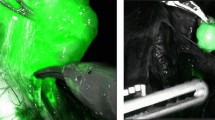Abstract
Optical imaging is a relatively inexpensive, fast, and sensitive addition to a surgeon’s arsenal for the non-invasive detection of malignant dissemination. Optical cameras in the near infrared spectrum are able to successfully identify injected indocyanine green in lymphatic channels and sentinel lymph nodes. The use of this technology is now being used in the operating room to help with lymph node dissection and improve the prognosis of patients diagnosed with muscle invasive bladder cancer. Indocyanine green has the potential for many more applications due to its versatility. In the future, there is a potential to use it for lymphangiography during nephroureterctomy for upper tract urothelial carcinoma, adrenal surgery for partial or radical adrenalectomy. Further investigations at multiple centers will validate this technique and its efficiency.

Similar content being viewed by others
References
Papers of particular interest, published recently, have been highlighted as: • Of importance •• Of major importance
Vazina A et al. Stage specific lymph node metastasis mapping in radical cystectomy specimens. J Urol. 2004;171(5):1830–4.
Leissner J et al. Extended radical lymphadenectomy in patients with urothelial bladder cancer: results of a prospective multicenter study. J Urol. 2004;171(1):139–44.
Hawrysz DJ, Sevick-Muraca EM. Developments toward diagnostic breast cancer imaging using near-infrared optical measurements and fluorescent contrast agents. Neoplasia. 2000;2(5):388–417.
Jiang H, Ramesh S, Bartlett M. Combined optical and fluorescence imaging for breast cancer detection and diagnosis. Crit Rev Biomed Eng. 2000;28(3–4):371–5.
Ogawa M et al. In vivo molecular imaging of cancer with a quenching near-infrared fluorescent probe using conjugates of monoclonal antibodies and indocyanine green. Cancer Res. 2009;69(4):1268–72.
Becker A et al. Receptor-targeted optical imaging of tumors with near-infrared fluorescent ligands. Nat Biotechnol. 2001;19(4):327–31.
Liebert A et al. Non-invasive detection of fluorescence from exogenous chromophores in the adult human brain. Neuroimage. 2006;31(2):600–8.
Troyan SL et al. The FLARE intraoperative near-infrared fluorescence imaging system: a first-in-human clinical trial in breast cancer sentinel lymph node mapping. Ann Surg Oncol. 2009;16(10):2943–52.
Liedberg F et al. Intraoperative sentinel node detection improves nodal staging in invasive bladder cancer. J Urol. 2006;175(1):84–8. discussion 88–9.
Marits P et al. Detection of immune responses against urinary bladder cancer in sentinel lymph nodes. Eur Urol. 2006;49(1):59–70.
Sherif A et al. Lymphatic mapping and detection of sentinel nodes in patients with bladder cancer. J Urol. 2001;166(3):812–5.
Sherif A et al. Hybrid SPECT-CT: an additional technique for sentinel node detection of patients with invasive bladder cancer. Eur Urol. 2006;50(1):83–91.
Sevick-Muraca EM, Rasmussen JC. Molecular imaging with optics: primer and case for near-infrared fluorescence techniques in personalized medicine. J Biomed Opt. 2008;13(4):041303.
de Boer A et al. Liver blood flow as a major determinant of the clearance of recombinant human tissue-type plasminogen activator. Thromb Haemost. 1992;67(1):83–7.
Gurfinkel M et al. Pharmacokinetics of ICG and HPPH-car for the detection of normal and tumor tissue using fluorescence, near-infrared reflectance imaging: a case study. Photochem Photobiol. 2000;72(1):94–102.
Intes X et al. In vivo continuous-wave optical breast imaging enhanced with indocyanine green. Med Phys. 2003;30(6):1039–47.
Licha K et al. Hydrophilic cyanine dyes as contrast agents for near-infrared tumor imaging: synthesis, photophysical properties and spectroscopic in vivo characterization. Photochem Photobiol. 2000;72(3):392–8.
Hope-Ross M et al. Adverse reactions due to indocyanine green. Ophthalmology. 1994;101(3):529–33.
Obana A et al. Survey of complications of indocyanine green angiography in Japan. Am J Ophthalmol. 1994;118(6):749–53.
Jeschke S et al. Visualisation of the lymph node pathway in real time by laparoscopic radioisotope- and fluorescence-guided sentinel lymph node dissection in prostate cancer staging. Urology. 2012;80(5):1080–6.
Knapp DW et al. Sentinel lymph node mapping of invasive urinary bladder cancer in animal models using invisible light. Eur Urol. 2007;52(6):1700–8.
Ishizawa T et al. Real-time identification of liver cancers by using indocyanine green fluorescent imaging. Cancer. 2009;115(11):2491–504.
Schaafsma BE et al. Optimization of sentinel lymph node mapping in bladder cancer using near-infrared fluorescence imaging. J Surg Oncol. 2014;110(7):845–50. First modern clinical study evaluating injetion techniques for indocyanine green during radical cystectomy.
Mieog JS et al. Toward optimization of imaging system and lymphatic tracer for near-infrared fluorescent sentinel lymph node mapping in breast cancer. Ann Surg Oncol. 2011;18(9):2483–91.
Manny TB, Krane LS, Hemal AK. Indocyanine green cannot predict malignancy in partial nephrectomy: histopathologic correlation with fluorescence pattern in 100 patients. J Endourol. 2013;27(7):918–21.
Manny TB, Patel M, Hemal AK. Fluorescence-enhanced robotic radical prostatectomy using real-time lymphangiography and tissue marking with percutaneous injection of unconjugated indocyanine green: the initial clinical experience in 50 patients. Eur Urol. 2014;65(6):1162–8.
Manny TB, Hemal AK. Fluorescence-enhanced robotic radical cystectomy using unconjugated indocyanine green for pelvic lymphangiography, tumor marking, and mesenteric angiography: the initial clinical experience. Urology. 2014;83(4):824–9. Modern study examining multiple uses of indocyanine green in bladder cancer using a robotic platform. Study demonstrates lymph node drainage as well as other concominant uses of ICG.
Menon M et al. Nerve-sparing robot-assisted radical cystoprostatectomy and urinary diversion. BJU Int. 2003;92(3):232–6.
Author information
Authors and Affiliations
Corresponding author
Ethics declarations
Conflict of Interest
Manish N. Patel and Ashok K. Hemal each declare no potential conflicts of interest.
Human and Animal Rights and Informed Consent
This article does not contain any studies with human or animal subjects performed by any of the authors.
Additional information
This article is part of the Topical Collection on New Imaging Techniques
Rights and permissions
About this article
Cite this article
Patel, M.N., Hemal, A.K. Molecular Targeted Fluorescence-Guided Intraoperative Imaging of Bladder Cancer Nodal Drainage Using Indocyanine Green During Radical and Partial Cystectomy. Curr Urol Rep 17, 74 (2016). https://doi.org/10.1007/s11934-016-0633-z
Published:
DOI: https://doi.org/10.1007/s11934-016-0633-z




